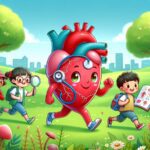Leg-Calve-Perthes Disease is a condition that affects the hip joint in children, primarily those aged between four and eight. It occurs when the blood supply to the round head of the femur (thigh bone) is temporarily disrupted, causing the bone to begin to die. This article aims to demystify this condition for new parents, providing deep insights and valuable information on diagnosis, treatment, and supporting a child with Leg-Calve-Perthes Disease.
What is Leg-Calve-Perthes Disease?
Leg-Calve-Perthes Disease is a rare hip disorder that impacts the femur, leading to a range of mobility issues and discomfort in young children. As the blood supply to the femoral head is compromised, the bone may begin to fray and reshape, affecting the hip’s stability and function. Over time, the body will attempt to heal, which can lead to the bone regrowing, but often not in its original shape.
The exact cause of the disruption in blood supply is not known, but factors such as genetics, environmental influences, and certain health conditions may play a role. Early detection and treatment are crucial for a favorable outcome and to minimize long-term effects on the hip joint and child’s mobility. For more detailed information, parents can visit the Mayo Clinic’s overview on Leg-Calve-Perthes Disease.
Signs and Symptoms of Leg-Calve-Perthes Disease
The initial signs of Leg-Calve-Perthes Disease can be subtle and vary from child to child. Common symptoms include limping, pain in the hip, thigh, or knee, and reduced range of motion in the affected hip. Some children may also experience stiffness in the hip, especially in the morning or after periods of rest. It’s essential to monitor your child for these symptoms and consult a pediatrician if you have any concerns.
As the disease progresses, symptoms may become more pronounced. Parents might notice their child avoiding activities that put strain on the hip or preferring to rest more frequently. Early intervention can significantly improve the prognosis, so recognizing these signs early on is critical. For parents looking for more information on symptoms, the link to Leg-Calve-Perthes Disease on BabyWhysAndHows offers valuable insights.
Treatment Options for Leg-Calve-Perthes Disease
Treatment for Leg-Calve-Perthes Disease aims to ensure the femur head can fit properly in the hip socket as it regrows. This involves a combination of rest, physical therapy, and in some cases, surgery. The specific treatment plan will depend on the severity of the disease, the child’s age, and the stage of the condition at diagnosis.
Non-surgical treatments may include anti-inflammatory medications to reduce pain, physical therapy to improve range of motion, and activity restrictions to protect the hip. In more severe cases, surgery might be necessary to reshape the hip or to ensure the femur and hip socket align properly during the healing process. For an in-depth look at treatment options, the article on BabyWhysAndHows provides comprehensive insights.
Supporting Your Child Through Recovery
Supporting a child with Leg-Calve-Perthes Disease goes beyond medical treatment. Emotional and psychological support is crucial as the child may feel frustrated or isolated due to their limited mobility and activity restrictions. Encouraging participation in non-impact activities, such as swimming or cycling, can help maintain their spirits and physical health.
Additionally, parents should maintain open communication with their child’s healthcare team to monitor progress and adjust treatment as needed. Support groups and resources for families dealing with Leg-Calve-Perthes Disease can also provide comfort and practical advice during this challenging time. For more resources, visiting sites like BabyWhysAndHows on Hip Dysplasia might offer useful information and support options.
Preparing for Your Child’s Long-Term Health
While Leg-Calve-Perthes Disease can be a challenging condition for both the child and family, most children recover well and lead active, healthy lives. Long-term monitoring of the hip joint’s health is important, as some children may develop arthritis later in life. Regular follow-ups with a pediatric orthopedist can help catch and address any potential issues early.
Encouraging a healthy lifestyle with a balanced diet and regular exercise can also support your child’s joint health. Additionally, educating your child about their condition and its impact can empower them to take an active role in their health as they grow. For more insights on supporting long-term health after Leg-Calve-Perthes Disease, exploring additional reading on developmental milestones and physical activity for children can be beneficial.













